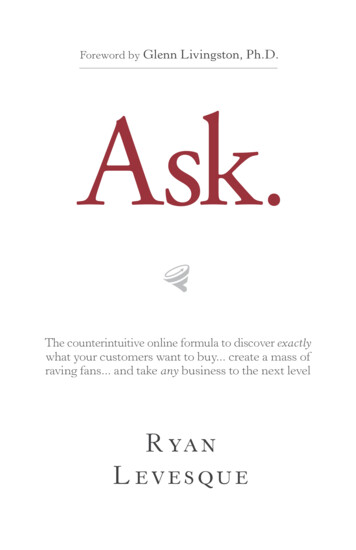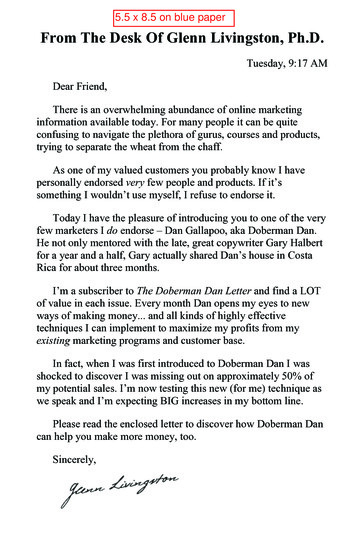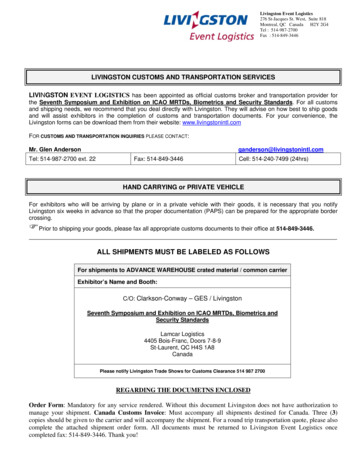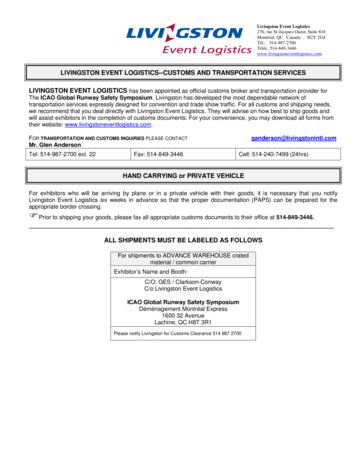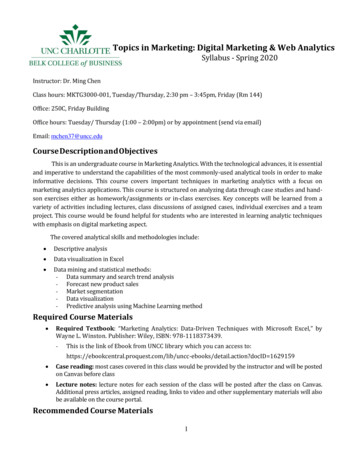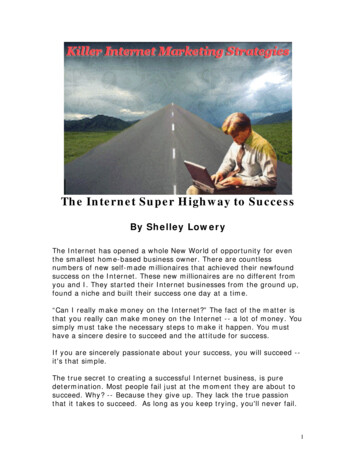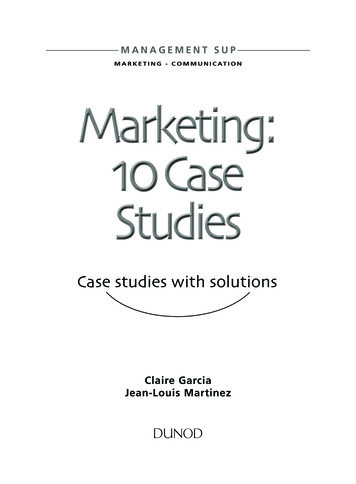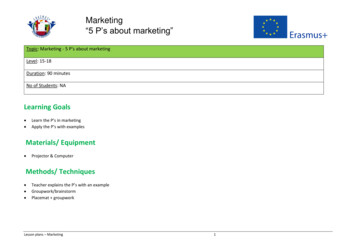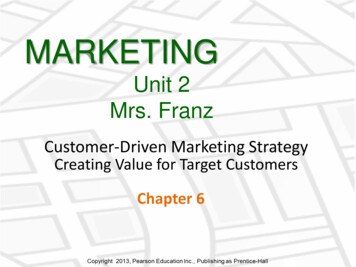
Transcription
MARKETINGUnit 2Mrs. FranzCustomer-Driven Marketing StrategyCreating Value for Target CustomersChapter 6
First Stop: Dunkin’ Donuts: Targetingthe Average JoeDunkin’ Donuts positions itself asserving simple fare at a reasonable price This positioning resonated strongly with customers duringthe recessionRefreshes its menu keeping in mind the preferences of thecustomers it attractsRanks number one in the coffee category in a leadingcustomer loyalty survey
Figure 6.1 - Designing a CustomerDriven Marketing Strategy6-3
Dividing a market into smaller segments of buyersMarketsegmentation with distinct needs, characteristics, or behaviors thatmight require separate marketing strategies or mixesMarkettargetingThe process of evaluating each market segment’sattractiveness and selecting one or more segmentsto enterDifferentiation Differentiating the market offering to create superiorcustomer valuePositioningArranging for a market offering to occupy a clear,distinctive, and desirable place relative to competingproducts in the minds of target consumers6-4
Segmenting Consumer onPsychographicBehavioralsegmentationsegmentation
SegmentationHarley-Davidson has traditionallytargeted men between 35 and 55years old, but women are now amongits fastest-growing customersegments. Female buyers account for12 percent of new Harley-Davidsonpurchases
Marketing at Work Car-sharing serviceZipcar focuses ondensely populatedmetropolitan areasand colleges,positioning itself asa low-cost, lowhassle alternative toowning your own carhttp://www.zipcar.com/
Using Multiple Segmentation Bases The Nielsen PRIZMsystem Claritas Based ondemographic factors Classifies U.S.households into 66demographically andbehaviorally distinctsegments6-8
Target market A set of buyers sharing common needs orcharacteristics that the company decides to serve
Figure 6.2 - Market TargetingStrategies6 - 10
Undifferentiated MarketingMASS Marketing A firm decides to ignore market segmentdifferences and go after the whole marketwith one offer Focuses on what is common in the needs ofconsumers Designs a product that will appeal to thelargest number of buyers
DifferentiatedSegmented Marketing A firm decides totarget severalmarket segmentsand designsseparate offers foreachHallmark’s three ethnic lines—Mahogany, Sinceramente Hallmark, andTree of Life—target African-American,Hispanic, and Jewish consumers,respectively
ConcentratedNiche Marketing A firm goes after alarge share of one ora few segments orniches Can fine-tune itsproducts, prices, andprograms to theneeds of carefullydefined segmentsThanks to the reach and powerof the Web, online nicher Etsy—sometimes referred to as eBay’sfunky little sister—is thriving
Micromarketing Tailoring products and marketing programs tothe needs and wants of specific individualsand local customer segmentsLocalmarketingIndividualmarketing
Marketing at Work Local “Deal-of-the-day”Web marketers—such as Groupon—partner with localbusinesses to offershopping deals tosubscribers based onwhere they live andwhat they likeGroupon partners with retailers ineach city to craft attractive offersfor area customers
Marketing in Action IndividualThe ultimate in individual marketing: video screens insome stores can determine who’s watching them andchange ads accordingly.
Formative: Market SegmentationYou have been asked by your college/university to helpdevelop a market segmentation strategy for them.Name your collegeUsing your notes, Discuss and decide as a group what marketsegments would you encourage them to pursue and why?
DO NOW:Janet is married with two children. She is acollege graduate with a household income of 75,000 per year. What type of segmentationvariables are being used to describe icBehavioral
Janet is married with two children. She is a collegegraduate with a household income of 75,000 peryear. What type of segmentation variables are beingused to describe havioralDemographic segmentation divides the market intogroups based on variables such as age, gender, familysize, family life cycle, income, occupation, education,religion, race, generation, and nationality.6-19
ValsWhat does Vals stand for?VALS is based on selected psychological traits and key demographicsinstead of values, so we dropped Values and Lifestyles but retained theVALS brand.What is VALS used for?U.S. VALS segments English-speaking adults ages 18 years and older onthe basis of psychological traits that correlate with purchase behavior andkey demographics, enabling users to understand not just what, but whyconsumers exhibit certain preferences and attitudes. Marketers, strategicplanners, new-product designers and others use VALS to:1.2.3.4.Segment their customers and prospectsSelect targetsPosition brands, products, and even policies to the targetsDevelop communications that resonate with and motivate targets totake action.
In Microsoft WordWhat is your Primary?What is your Secondary?
VALS s/Understanding customers is critical to marketing.VALS strengthens demographic characterizationsby explaining the deeper psychological drivers ofconsumer behavior.1. Assess how well your "VALS" type represents you2. Read case summaries on how variouscompanies have used VALS data to improve yourmarketing efforts.3. Class discussion on your findings.
Do NowWhat are the four steps in creating amarketing strategy?
Differentiation and Positioning The company must decide on a valueproposition: How it will create differentiated value for targetedsegmentsWhat positions it wants to occupy in those segments Product position - The way a product isdefined by consumers on importantattributes6 - 24
Differentiation and Positioning A firm can createdifferentiation on: ProductServicesChannelsPeopleImageSeventh Generation, a maker ofhousehold cleaning supplies,differentiates itself not by how itsproducts perform but by the factthat its products are greener6 - 25
Figure 6.3 - Positioning Map: LargeLuxury SUVs6 - 26
Cars
Positioning Map Example
DO NOW:The way the product is defined by consumers onimportant attributes—the place the productoccupies in consumers’ minds relative tocompeting products—is known as the ifferentiation
The way the product is defined byconsumers on important attributes—theplace the product occupies in consumers’minds relative to competing products—is known as fferentiationA product’s position is the way the product is definedby consumers on important attributes.6-30
Competitive advantage An advantage over competitors gained byoffering greater customer value, either byhaving lower prices or providing morebenefits that justify higher prices6 - 31
Choosing the Right CompetitiveAdvantages Purex Complete 3in-1 is positioned onmultiple benefits The challenge is toconvince customersthat one brand cando it all
Facebook Vs. MySpaceWhat the competitive advantage didFacebook have over MySpace?MySpace still has advantages. What arethey?Watch Video on FB advantages
Choosing the Right CompetitiveAdvantages Choose whether to promote a single benefitor multiple benefitsIn your notes: Think Pair ShareHow have each of these fast-food companiesdifferentiated their products?McDonald'sBKWendy'sKFCSubway6 - 34
Group Presentations
Do Now:What is the difference between apositioning map and a positioningstatement?
Draw this upside-downT box in your notes
Developing a PositioningStatement A statement that summarizes company orbrand positioning using a standard format. All the company’s marketing mix efforts mustsupport the chosen positioning strategy
Differentiation and Positioning cont. Developing a positioning statement:Format: “To (target segment and need)our (brand) is (a concept) that (point ofdifference).”Brand positioning video(Stop at 6 min. mark)6 - 39
Position Statement ExampleWrite in the left side of your T notes.“To busy, mobile professionals who need to alwaysbe in the loop, the BlackBerry is a wireless businessconnectivity solution that gives you an easier, morereliable way to stay connected to data, people, andresources while on the go.”Circle (target segment and need) (brand) (a concept) (point of difference)
Rest Stop: Previewing the Concepts Define the major steps in designing acustomer-driven marketing strategy: marketsegmentation, targeting, differentiation, andpositioning6 - 41
First Stop: Dunkin’ Donuts: Targeting the Average Joe Dunkin’ Donuts positions itself as serving simple fare at a reasonable price This positioning resonated strongly with customers during the recession Refreshes its menu keeping in mind the preferences of the customers it attracts
